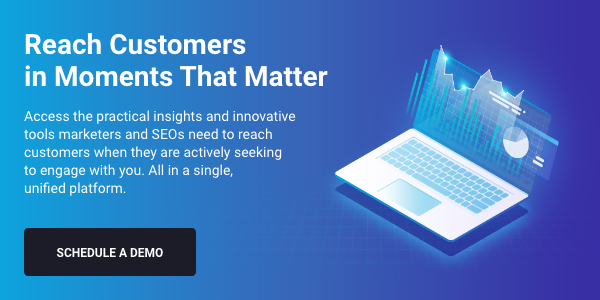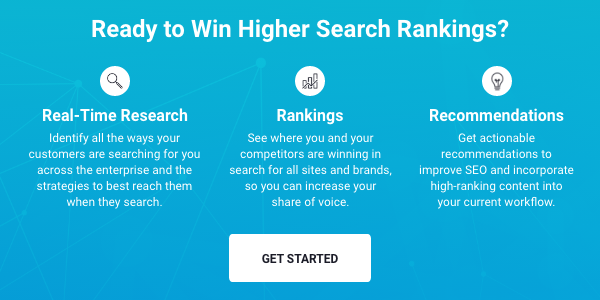These books describe a new approach to understanding, connecting and motivating your buyer. Big, spendy, inefficient budgets are out and creating smart content is in. Maybe this is a by-product of the great recession of 2021; people started to look very closely at what they could get for a million bucks or a hundred thousand bucks. Executives started to press Marketers and SEOs to look at how to get more juice for the squeeze since the search changes from COVID-19.
The focus on earned media exploded. You won't believe the earned media findings in our latest channel share report. One digital channel continues to grow and this data will help you make the case and prioritize your traffic efforts.
1. Unleash Possible: A Marketing Playbook that Drives Sales
by Samantha Stone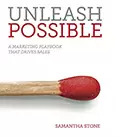
Stone delivers the goods with a 15-chapter playbook that includes the frameworks, question lists, and templates that make you want to put the book down and try the tactics recommended.
There are very few good B2B marketing books on product marketing that make the discipline more clear without burying you in too much theory or too many worksheets, but Stone does an excellent job detailing it. She has practical advice on how to move beyond profiles to personas and solid go-to-market planning.
Download the SEO initiatives playbook.
Another great section is on account based marketing, where she explains the unique role marketing plays in defining and running a significantly different program.
She brings her extensive approach and skill as a consultant and experienced marketer to the challenges of a Marketing Playbook that Drives Sales.
Highly recommended B2B read as we head into 2020.
2. The Challenger Customer: Selling to the Hidden Influencer Who Can Multiply Your Results
By 2015 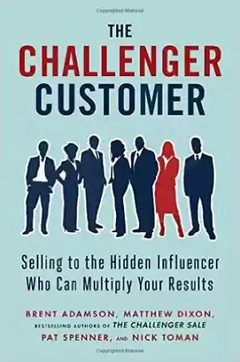
4.6 rating on Amazon | #16,817 on Amazon
The name on this one is a bit deceptive. This book is the sequel to the immensely popular and interesting Challenger Sale. The Challenger Sale used research to show that the most successful sales people are the ones who sell with knowledge and value add with education. In the Challenger Customer, the authors go deep into the mind and the context of the buyer commission to prove how vital information and education are to helping them make the case for your product.
A key statistic they share is that purchase intent drops directly with the number of people involved in the decision, from 81% with 1 person to 45% with 5.4 people. The odds are against the solution seller because solutions are usually bought by groups not individuals.
By now everyone in B2B marketing and sales is familiar with the concept of securing a champion on the customer side to help shepherd the order over the line. The challenger authors determined that there are an average of 5.4 people involved in each deal in a B2B sale. Therefore, it is not just a single champion you need, but a challenger champion who can effectively persuade the other 4.4 people to buy your solution.
Chapter 10 is my favorite as it details the impact of this approach on demand generation. In short, their advice is to shift from qualifying leads generally, like in a BANT (budget, authority, need, timing) model, to qualify leads according to your unique differentiators and criteria. Don't generate demand; mobilize the right demand. Create content paths that confront and connect to your differentiators. Adjust lead scoring criteria to reflect confrontation and connection. Nurture leads explicitly for commercial insight.
You can tell from the words in this quick summary that the concepts are fresh, original, and insightful. That is why The Challenger Customer is a terrific marketing and sales book.
3. The Challenger Sale: Taking Control of the Customer Conversation
By 2011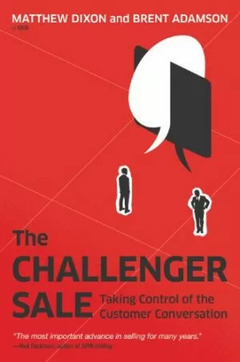
4.4 rating on Amazon | #2892 on Amazon
If my #1 on the list is Challenger Customer, then Challenger Sale has to be close by on the list as well. In just 8 years, Challenger Sale thinking and lexicon are already deeply ingrained in B2B technology selling. First off, no one aspires to sell software but instead to sell solutions. No one aims to be a supplier but instead a solutions provider. No one wants to be vendor but now everyone wants to be a trusted adviser.
Based on an extensive study of thousands of sales reps across multiple industries and geographies, The Challenger Sale argues that classic relationship building is a losing approach, especially when it comes to selling complex, large-scale business-to-business solutions. The relationship-building rep often loses control of a deal when their relationship-oriented contact fails to persuade colleagues to support the purchase.
Instead of bludgeoning customers with endless facts and features about their company and products, Challengers approach customers with unique insights about how they can save or make money. They tailor their sales message to the customer's specific needs and objectives.
Rather than acquiescing to the customer's every demand or objection, the framework recommends challengers be assertive, pushing back when necessary and taking control of the sale. As a buyer, I am not sure how effective it is for people selling in a new solution to try to overtake control of the sales process. I usually do not let that happen.
The things that make Challengers unique are replicable and teachable to most sales reps. Once you understand how to identify the Challengers, you can model their approach and embed it throughout your sales force. People who understand the Challenger model and make it work then take the appropriate step of screening for the behaviors and traits as they hire to increase the proportion of productive challengers on the team. Learn how to capture year-end B2B budget.
Both challenger B2B marketing books are put out by CEB (Corporate Executive Board), which surprisingly is a publicly-traded, huge, global consulting company with a $2B market cap. The Challenger Sale is a breakthrough work and an instant classic for B2B marketers who must partner closely with their B2B sales counterparts.
4. Never Split the Difference: Negotiating as If Your Life Depended on It
By Chris Voss, 2016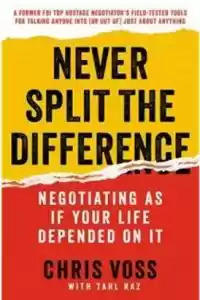
4.8 rating on Amazon | #277 on Amazon
I resisted reading this book for the first 2 years because I thought it would be a maximally capitalist tome on how to dazzle your opponent and eat their lunch. Not that I don't want to do that sometimes, but somehow I did not want to see myself as someone who took the time to study how to do that.
To my surprise the book and its methodology closely resemble the sales training I provide to new sales reps at BrightEdge. Former FBI hostage negotiator Chris Voss' strategy starts with open-ended questions, like "How do I even know you have the capacity to meet that schedule?" Next he recommends mirroring the other persons words and behaviors, which is a tactic my sales trainer explained to me 25 years ago when I was a new sales rep.
The next 2 tactics were very fresh, tactical empathy and label their pain. It actually shocks me how often empathy comes up in business literature in the last few years. Voss combines common sense listening and empathy with labeling the other person's issue, much like a political candidate tries to label an opponent before they have a chance to define themselves. Beware of Yes and master No are two more Voss originals. He goes on with chapters on getting them to say "That's right" and "Bend Their Reality" and "Bargain Hard."
So never split the difference does not mean that you grind away until the other person gives in, it means you operate at deeper and more sophisticated levels and grind away to win them over to your view. You can see why this book is one of the best B2B marketing books and is my top B2B book recommendation for 2018.
5. Growth Hacker Marketing: A Primer on the Future of PR, Marketing, and Advertising
By Ryan Holiday, 2014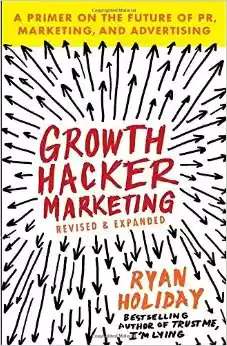
4.3 rating on Amazon | #7298 on Amazon
If you like short B2B marketing books and quick reads, this book is only 77 pages. Of the many hacker-themed books this one is the most marketing-focused. Author Ryan Holiday has an interesting background: he dropped out of college at 19 and rose to VP of Marketing at American Apparel, and when he learned about growth hacker marketing, he resigned and became a promotional consultant.
Growth hacking is one of those terms that started to make me nervous after it broke in 2012 in Andrew Chen's post. I kept hearing it and I started to worry that it was either going to be a game-changing concept that would select the next wave of top marketing managers and the has-beens or it would fade. It was and is prominent in the start-up and software industry that employees me.
Holiday defines a growth hacker marketer as someone who throws out the traditional marketing playbook that includes big launches, large media budgets, and uncertain connectivity to results for "only what is testable, trackable, and scalable. ... growth hackers relentlessly pursue users and growth." Unlike some trendy concepts, this definition is a reasonable evolution of Internet marketing 1.0. Like Lean Startup it biases for minimum viable product and extensive testing to prove yield before additional investment.
The book begins with the line: "You know what the single worst marketing decision you can make is? Starting with a product nobody wants and nobody needs?" For us marketers, that could be right up there with "Call me Ishmael." If you have ever had to twist yourself and your team into a pretzel to spin a product or service, then you have been in this position. The solution for this condition is to develop product-market fit, which means that you adapt your product to match it to your market instead of the other way around. Lack of fit leads to over-investing in communication to muscle the market's interest in your product.
Check out this great free deck with inspiring growth hacker quotes.
Out of all these B2B marketing books, this one is both simple and revolutionary. I think you will also.
6. Start with Why: How Great Leaders Inspire Everyone to Take Action
By Simon Sinek, 2009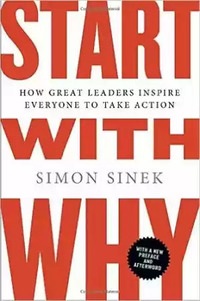
4.5 rating on Amazon | #433 on Amazon
My marketing team was working on an asset recently and our head of product marketing reorganized the message to start with why and use the customer voice as the lead and end with the what and how. Why is a stronger opener and a better hook. Why gets us to focus on the source of benefits and not features.
Sinek starts his work with a fundamental question: Why are some people and organizations more innovative, more influential, and more profitable than others? Why do some command greater loyalty from customers and employees alike? Even among the successful, why are so few able to repeat their success over and over?
How does a company create strong kinship with customers? The book explains the Golden Circle concept, which shows how to inspire with why instead of trying to manipulate customers or employees to act. Sinek explains that trust is built naturally when you target customers that understand and believe in your why.
Sinek argues that when you start with why you get to the heart of what motivates you - why you do what you do as a company - and that purposefulness attracts people and loyalty to your company and products. When marketing, sales, and customer reps understand why they sound authentic, it wins people over.
B2B marketing books are not all full of specific best practices or how-tos, but in this one, the big idea is worth the price of admission for everyone in the communication business. Starting with why is the cure for starting with a wordy description of what you sell and what it does.
You can listen to Sinek explain start with why in his TED talk, which has been viewed more than 29 million times on the Ted Talks site alone.
7. Driving Demand: Transforming B2B Marketing to Meet the Needs of the Modern Buyer
By Carlos Hidalgo, 2016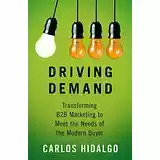
5.0 rating on Amazon | #200,616 on Amazon
B2B marketers may know that there are very few good B2B marketing books on systems. Carlos Hidalgo provides a clear roadmap and framework on how B2B organizations can implement change management and transform their demand generation from traditional outbound systems to efficient outbound/inbound systems. Hidalgo includes case studies and excerpts from B2B marketing practitioners and clients who have transformed their organizations, and how they accomplished this change are incorporated throughout the book.
Driving Demand gives Marketing and Sales an understanding of why they are not achieving the results they want and how to remedy it. Hidalgo explains why change management is a necessary part of marketing organizations today and how top-performing organizations focus on the buyer when developing a demand generation strategy. Driving Demand gives a unique perspective on why it's time to transform B2B marketing and specifically how to do it.
It includes a mix of inbound and outbound marketing demand generation and shows how B2B marketing is really the marriage of marketing programs coupled with a structured sales process.
B2B marketing books like this are excellent and provide pragmatic advice as to how to transform the B2B marketing function to match the way customers go about buying these days. The author's extensive experience is shared in a way that is actionable for many Marketing and Sales leaders, yet also points out attempts that did not work - and why it failed.
A lot of the examples include advice as to how to navigate the resistance to change that so many organizations suffer from, but after reading this book it should give the marketer who is willing to challenge the status quo the added confidence needed to press forward and take in the challenge.
8. The Membership Economy: Find Your Super Users, Master the Forever Transaction, and Build Recurring Revenue
By Robbie Kellman Baxter, 2015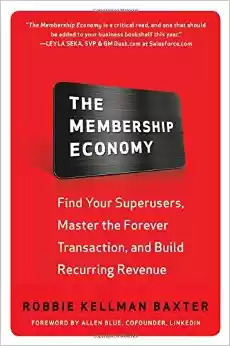
4.8 rating on Amazon | #61,214 on Amazon
Digital has changed the consumption model for many categories from a preference for owning things to having fast, convenient access. Consider movies, music, photos, books, cars, bikes, enterprise software, and even physical fashion items, like purses and shoes.
The difference defines the approach of ownership companies verses membership companies. Membership companies are more likely to consider lifetime value, giving users more flexibility and control, adding continuous value, and building a relationship directly from the brand to the consumer. Those four differences are dramatic and require a completely different mindset from the companies that seek to provide them. In membership, customers are more aware of what the company does for them, identify more closely with it, and are more likely to discuss and recommend them. Think about how readily and happily Uber and AirBnB users switched the verb for getting a taxi and finding a hotel to Ubering and AriBnBing. Not only did they make the switch, but you could hardly stop them from talking about it. That's identification marketing and membership.
Previously membership was about exclusivity and status with high barriers to entry, like a tennis club or think about American Express' slogan: "Membership has its privileges." Modern membership is about inclusivity and equality and has virtually no barriers to entry.
In a membership-driven organization, Marketing should "ensure that the offerings the organization creates meet the ongoing requirements of the target buyers and that those prospective buyers know about the benefits of the offering, sign up, and become loyal." The membership philosophy is an impactful basis for proper customer marketing. An intriguing and refreshing read.
Ironically, Baxter does not offer a link to a community to become a member in the community for the book, but you can see her consulting website and sign up for her newsletter.
9. From Impossible to Inevitable: How Hyper-Growth Companies Create Predictable Revenue
By Aaron Ross, 2016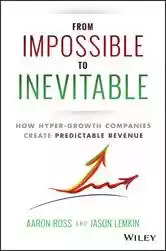
4.3 rating on Amazon | #7,350 on Amazon
Ross wrote the immensely influential Predictable Revenue which, since its publication in 2011, has redefined the lead generation and prospecting models and roles for SaaS companies. The book is dense with advice and examples and took me weeks to get through. It includes strategy and specific tactics and advice. It feels like a series of one-on-ones with a talented and respected executive mentor.
Marketing, when properly integrated, is a key driver of revenue growth. He outlines 3 approaches, 1) Seeds, 2) Nets, 3) Spears. Seeds are happy customers and word of mouth. 2) Nets are one-to-many campaigns, like content and inbound marketing. Spears are targeted outbound campaigns. He goes into explicit detail on how to organize the inbound SDRs at various stages, which is an issue I have dealt with actively over the last few years at BrightEdge.
Ross states that marketing should be led by a demand generator and not a brander. He says that demand marketers can handle the "squishy" marketing stuff well enough but brand marketers cannot handle the demand generation effort.
He explains in detail how to plan and develop the sales and growth effort in SaaS companies in terms of picking the right size customers and going up-market and up-deal size at the right time. He adds a few chapters of realistic and achingly honest advice for start-ups and entrepreneurs.
The book includes many helpful lists and some simple and insightful diagrams. Overall it is an excellent and valuable resource, and I highly recommend it.
10. The Startup Pitch: A proven formula to win funding
By Chris Lipp, 2014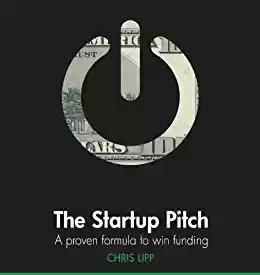
4.9 rating on Amazon | #7474 on Amazon in Entrepreneurship
I include this on the list of B2B marketing books because it has a significant internal persuasion-for-funding component. Entrepreneurs have to make their pitches clear and concise, and this knowledge and approach can help all types of B2B marketers in all size companies.
One of the things that stands out is the quality and precision of Lipp's prose. It is fresh and fun to read and the voice is neither corporate nor cheeky but, ultra-helpful and relevant. The book is meticulously structured and each chapter moves from a framework through explanation to specific pitch examples that won funding. In addition the book has a modern design and style including colored-font callouts that make it easy to read and re-skim.
Lipp starts with ground rules on: the audience, clarity, and concision. He moves on to the 4 areas of the pitch: Problem, Solution, Market, and Business. After Lipp introduces a thought framework, he provides additional drill down. In Problem, he recommends the sub-points of Description, Pains, and Trends. In Solution he break down further to Value Proposition, Demo, Benefits. In Market, he recommends Target, Size, and Advantages. In Business he offers Go-To-Market, Revenue Model, and Milestones. And at this point in the book, he has already shown you how to structure your deck.
Chapter 4 "Delivery Through Dialogue" belies the title of the book. In it Lipp describes how a pitch really works and that is by making it a relevant dialogue. He recommends that you know your audience, prepare for questions, answer questions, ask questions, and align yourself with the investors. He goes on with storytelling tips and attention capturing openers. Valuable for all types of business people and marketers.
11. Account Based Marketing
By Sangram Vajre, 2016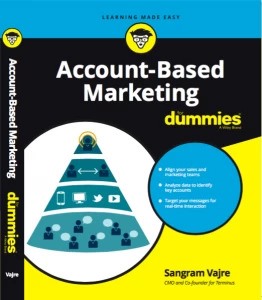
3.8 rating on Amazon | #667 on Amazon in Marketing
I am realizing that Wiley puts out most of the valuable B2B marketing books in this category. This is another in the Dummies series that is actually for sophisticated marketers.
Before ABM, there was a concept called Target Account Selling. ABM refined that and is a much more intentional kind of marketing that works to increase the yield of the funnel by shrinking the top or entry point. So, ABM is a funnel-flipping exercise where you start with Identifying a narrow group of target accounts, Expand contacts within the account, Engage the contacts, and then Close and build Advocates.
This 355-page book goes over ABM in a clear and organized way. The main concepts I took away were: Targeting your best-fit accounts, Tracking and reporting at the account level instead of the lead level, Improving the sales velocity, Leveraging customer advocacy.
Another important result is that the skill of targeting prospects with ABM is very close to targeting your existing customers to drive up-sell, cross-sell, and renewal.
Best B2B Marketing Books - Conclusion
So if you consider these B2B marketing books as a set, you recognize some recurring patterns around change management and adaptation. Marketers have to lead change within their organizations to lead the market outside of it. The Startup Pitch will teach you how to persuade and secure resources.
The Challenger Customer describes a strategy for selling to B2B buyers, The Challenger Sale tells you who to hire to sell it, Growth Hacker Marketing explains how to make a product for a market, Start With Why tells you how to attract and inspire, Driving Demand tells you in detail how to build a good B2B marketing system, and The Membership Economy tells you how to build loyalty, community, and recurring revenue.
Reading all these B2B marketing books will make you a better marketer and help you get more juice from your marketing squeeze.

